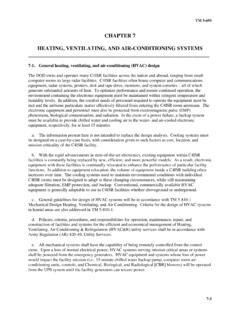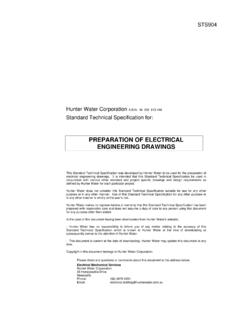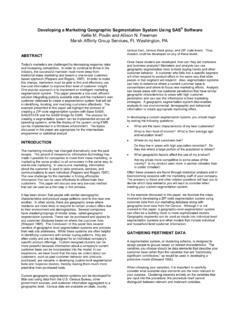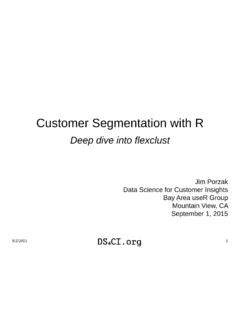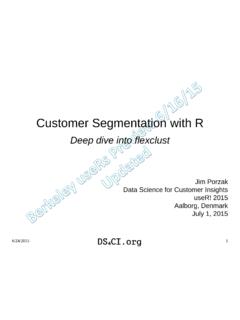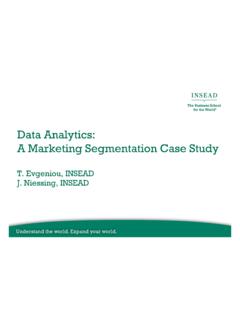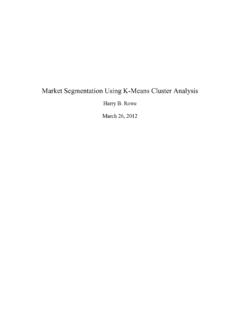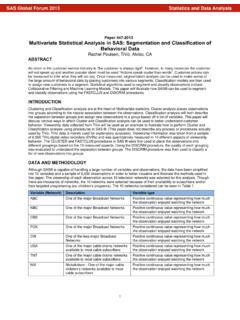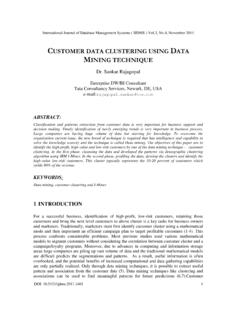Transcription of AN IMPROVED CLUSTERING ALGORITHM FOR …
1 AN IMPROVED CLUSTERING ALGORITHM FOR customer segmentation PRABHA DHANDAYUDAM Department of Computer Science and Engineering, Sri Krishna College of Engineering and Technology, Coimbatore, Tamilnadu, India Dr. ILANGO KRISHNAMURTHI Department of Computer Science and Engineering, Sri Krishna College of Engineering and Technology, Coimbatore, Tamilnadu, India Abstract customer segmentation is the process of grouping the customers based on their purchase habit. Data mining is useful in finding knowledge from huge amounts of data. The CLUSTERING techniques in data mining can be used for the customer segmentation process so that it clusters the customers in such a way that the customers in one group behave similar when compared to the customers in the other group based on their transaction details.
2 The Recency (R), Frequency (F) and Monetary (M) are the important attributes that determine the purchase behavior of the customer . In this, we have provided an IMPROVED CLUSTERING ALGORITHM for segmenting customers using RFM values and compared the performance against the traditional techniques like K-means, single link and complete link. Keywords: customer segmentation ; CLUSTERING ; customer Relationship Management; RFM method. 1. Introduction customer Relationship Management (CRM) technology is a mediator between customer management activities in all stages of a relationship (initiation, maintenance and termination) and business performance [Markus Wubben (2008)]. customer segmentation gives a quantifiable way to analyze the customer data and distinguish the customers based on their purchase behavior [Jing Wu and Zheng Lin (2005)].
3 In this way the customers can be grouped into different categories for which the marketing people can employ targeted marketing and thus retain the customers. Once the customers are segmented, rules can be generated to describe the customers in each group based on their purchase behavior. These rules can be used to classify the new customers to the appropriate group who have similar purchase characteristics. RFM method is very effective for customer segmentation [Jing Wu and Zheng Lin (2005)]. R means recency which indicates the time interval between the present and previous transaction date of a customer . F means frequency which indicates the number of transactions that the customer has done in a particular interval of time.
4 M means monetary which indicates the total value of the customer s transaction amount. It has been proven that the values of R, F and M decide the characteristics of the customer behavior [Newell (1997)]. Data mining is the process of extracting useful information from huge volumes of data. It finds a useful application in CRM where large amount of customer data are dealt [Ngai (2009)]. CLUSTERING technique in data mining produces clusters for the given input data where data in one cluster is more similar when compared to data in other clusters [Han and Kamber (2001)]. The similarity is measured in terms of the distance between the data. Distance can be calculated using the Manhattan distance and it is given by (1) niiiyxyxd|)(|),(Prabha Dhandayudam et al.
5 / International Journal of Engineering Science and Technology (IJEST)ISSN : 0975-5462 Vol. 4 February 2012695 In Eq. 1, n indicates the number of dimensions in the given data, x and y are the data in the data set, d(x, y) is the distance between data x and y. For the customer segmentation , the attributes R, F and M are used as the three dimensions in CLUSTERING technique. Customers can be segmented using other Artificial Intelligence (AI) methods like Self Organizing Map (SOM), Genetic ALGORITHM (GA), Particle Swarm Optimization (PSO) and Artificial Bee Colony (ABC). GA is a part of evolutionary computational technique. It is based on the process of natural evolution using operations like mutation and cross over.
6 The main disadvantage of GA is it is time consuming and it is difficult to make the solution converge to an optimal solution and has stability issues. SOM is an unsupervised neural network learning ALGORITHM . Neural network has interconnected processing elements and achieves input/output relationships. It is a trial and error method and suffers from long training time [Ching-Hsue Cheng and You-Shyang Chen (2009)]. PSO is an evolutionary computation technique developed by Kennedy and Eberhart (1995). Like GA, PSO has a fitness evaluation function that takes the particle s position and assigns to it a fitness value. The objective is to optimize the fitness function [Chui-Yu Chiu (2009)]. It has the same demerits as those of GA.
7 ABC are based on the behavior of honey-bees for food collection. A greedy selection mechanism is employed to choose the candidate solution which is tedious [Changsheng Zhang (2010)]. In this paper, an IMPROVED CLUSTERING ALGORITHM has been developed so that the customers are segmented to proper groups. The performance of the ALGORITHM is compared with other CLUSTERING algorithms like K-means, single link and complete link. The rest of the paper is organized in the following: In Section 2 we describe the overview of customer segmentation process and CLUSTERING algorithms. In section 3 we propose an IMPROVED CLUSTERING ALGORITHM for customer segmentation . In Section 4 we compare the results obtained using various CLUSTERING algorithms.
8 Finally in Section 5 we conclude the best CLUSTERING ALGORITHM according to the criteria chosen for comparison. 2. Literature Review customer segmentation CRM comprises a set of processes and enabling systems supporting a business strategy to build long term, profitable relationships with specific customers [Ling and Yen (2001)]. It is an important technology in every business because all the businesses are customer centric. It consists of identifying, attracting, retaining and developing customers. customer identification includes target customer analysis and customer segmentation . Target customer analysis analyzes the customer characteristics to seek segments of customers [Woo (2005)].
9 customer segmentation is the process of dividing customers into homogeneous groups on the basis of common attributes [Zeling Wang and Xinghui Lei (2010)]. customer segmentation is typically done by applying some form of cluster analysis to obtain a set of segments [Mirko Bottcher (2009)]. The customer identification is followed by customer attraction which motivates each segment of customers in different way. customer retention and customer development deals with retaining the existing customers and maximizing the customer purchase value respectively [Ngai (2009)]. customer segmentation requires a comprehensive understanding of enterprise customers [Huaping Gong and Qiong Xia (2009)]. It is a popular method used by customer attraction phase for selecting customers in each segment [Dyche (2001)].
10 RFM analysis is used to identify and represent the customer characteristics by three attributes namely Recency (R), Monetary (M) and Frequency (F). R indicates the time interval between the present and previous transaction date of a customer . F indicates the number of transactions that the customer has done in a particular interval of time. M indicates the total value of the customer s transaction amount. Different groups of customers are segmented using their consuming behavior via RFM attributes. This ensures that the standards which cluster customer value are not established subjectively, so that the CLUSTERING standards are established objectively based on RFM attributes [Ching-Hsue Cheng and You-Shyang Chen.]
